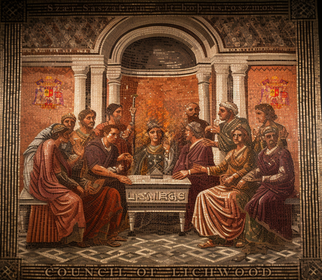Lichwood Conclave of 1740
Work in progress
The Lichwood Conclave of 1740 AN was a historic religious council convened by the Xinshi Light, acting at the behest of Steward Naïs Szodarvs and Cassian Wythe, to address the pressing matter of appointing a new Kaiser for Shireroth. Inspired by the legendary Council of Negrixnaht, the conclave gathered religious leaders, cult representatives, and notable figures of the Cedrist faith during a time of great turmoil in the Imperial Republic.
Held in Lichwood, within the Woodshire Circle, the conclave provided a unique opportunity for deliberation amidst war, facilitated by a six-day ceasefire between Shirerithian and Benacian Union forces. This temporary truce (limited to the Central Benacian region around Alalehzamin, Shirekeep and northern Brookshire), symbolically tied to the sacred number of Mors, the God of Death, allowed representatives from across the continent - and beyond - to assemble in peace.
Historical Context
The council was convened against the backdrop of the Mango Anarchy and the collapse of the Revolutionary Committee of Shirekeep, whose radical reforms had alienated much of the population. The continued captivity of Kaiseress Salome in Hurmu, where she underwent involuntary social harmonization therapy, further fueled political and religious uncertainty. The increasing military successes of supporters of the Kalirionists, particularly Tribune Karsten Koryandar’s costly but decisive victory at the Battle of Sabatini, had shifted the balance of power in Shirekeep and strengthened calls for the full restoration of the Golden Mango Throne. This convergence of religious, political, and military developments set the stage for the conclave as a means to resolve the imperial crisis.
Controversy Surrounding the Conclave
The Xinshi Light, as chairwoman of the conclave, introduced a bold and contentious proposal to include representatives from the Council of Araxion (United Ecclesiastical Corporation of Benacia), an entity associated with the Benacian Union. This decision provoked significant backlash from hardline Shirerithian factions, who viewed the inclusion of enemy religious leaders as an affront during wartime.
In defense of her decision, the Xinshi Light argued:
"While our country is at war, they too are servants of Cedrism and see the Golden Mango Throne as the religious cornerstone of our Faith."
This inclusive approach symbolized the broader Cedrist unity beyond political boundaries but remained highly divisive within Shireroth. One could argue that it also improved the chance for a temporary ceasefire and safe passage for all representatives, which was discussed between Shirerithian and Benacian diplomats behind closed door at that time.
Council Deliberations
The conclave brought together representatives from various Shirerithian religious cults, international Cedrist communities, and observing members. The three primary factions vying for influence and advocating for their preferred candidates for the Golden Mango Throne were:
- Crown Princess Kian’s Faction: the least likely candidate, as she had retreated herself to a monastery earlier in her life and had never actively sought the Throne. A coalition of reformists and moderates who sought a more inclusive and constitutional approach to governance were prefering her ascension to the Throne, as she would most likely be easier to deal with.
- Prince Yukio’s Faction: Supported by hardline Kalirionists and traditionalists who viewed Yukio as the rightful heir, despite that his Line was cut off from ascension by the Kaiseress. Heavily supported by the Jingdaoese nobility and - perhaps paradoxically - among the more Humanist aligned clergy.
- Prince Atreyu’s Faction: Seen by some as the only really legal choice.
Some members also supported the return of Kaiseress Salome, though her captivity and the controversial nature of her reign complicated this stance.
Invited Representatives
(If your nation has any Cedrist communities, you're free to add some representation)
From the Benacian Union (3 votes)
- The United Ecclesiastical Corporation of Benacia:
- Chancellor for the Divine Chancellery
- Representative for the Ecclesiastical Corporation of Hospitaliers
- Representative for the Sanguine Vigilate
From Shireroth (9 votes)
- Heavenly Light: Acting chairwoman and leader of the Tianchaodao
- High Priest (King of the Sacrifice) of the Cult of Mors
- High Priestess (Queen of the Sacrament) of the Cult of Viviantia
- Imperial Vicar of the Cult of the Sacred Detonation
- Imperial Vicar of the Imperial Cult
- Champion of the Cult of the Benac
- Reverend Mother of the Cult of Sakat
- Reverend Mother of the Cult of Alejia
- Imperial Vicar of the Cult of B'Caw
From Eura (1 vote)
- Survivor-in-Chief of the continental Order of the Nuclear Atonement
From the International Mandate (1 vote)
- Imperial Vicar of the Cedrist Temple of Tiegang
Observers
- Archbishop of the Batavian Catologian Church, not a Cedrist religion but affliated.
- Vicar of the Diocese of Dragonmoor.
- Archbishop of Northern Cibola, Victor Tetsuo
Proceedings
The council opened with solemn rituals dedicated to Mors and Viviantia, invoking the gods’ blessings for wisdom and guidance. A prayer to keep Mog, the God of Political Blunders out of the meeting, was also held. Over the next six days, attendees debated the qualifications, legitimacy, and spiritual significance of potential Kaisers. The discussions often mirrored the factional divides within the Imperial Republic, with fiery speeches and moments of reconciliation punctuating the proceedings.
The inclusion of Benacian representatives occasionally led to heated exchanges, but their presence underscored the shared religious heritage between the two sides. Observers noted that the council’s atmosphere, though contentious, marked a rare moment of unity amidst the chaos of war.
